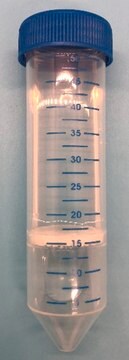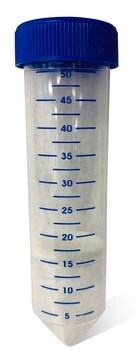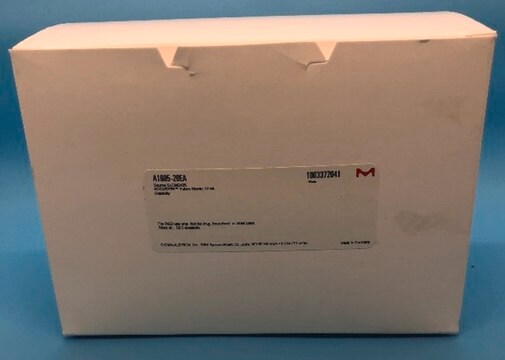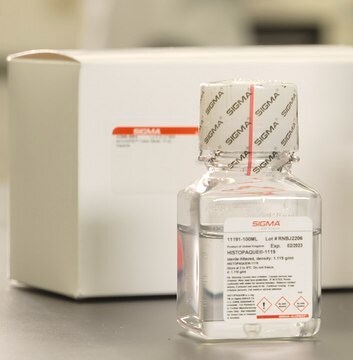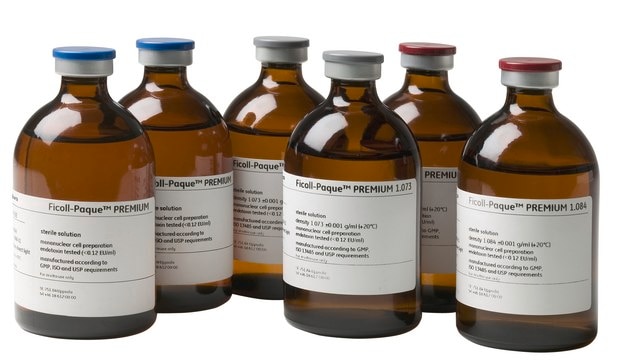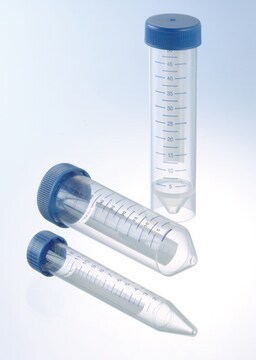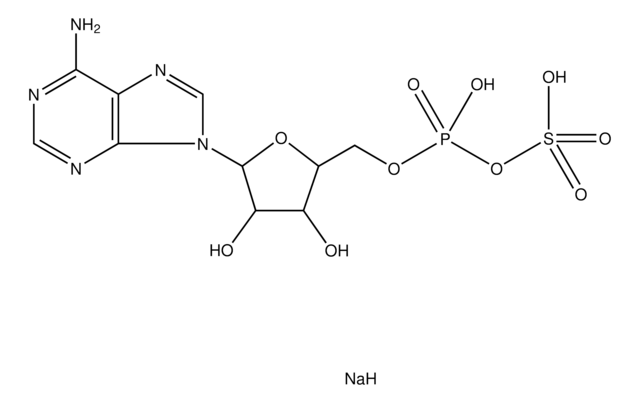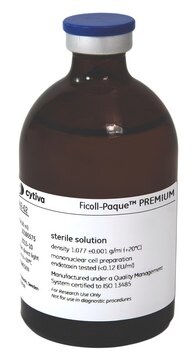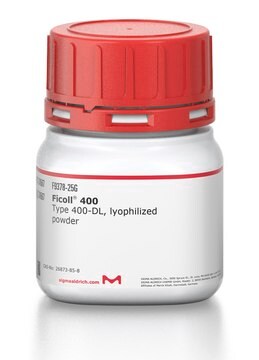A0561
ACCUSPIN™ System-Histopaque®-1077
sterile-filtered, density: 1.077 g/mL
Sign Into View Organizational & Contract Pricing
All Photos(2)
About This Item
Recommended Products
Quality Level
sterility
aseptically filled
form
solution
shelf life
Expiry date on the label.
packaging
package of 100 tubes
density
1.077 g/mL
application(s)
hematology
histology
storage temp.
2-8°C
Looking for similar products? Visit Product Comparison Guide
General description
ACCUSPIN System-Histopaque-1077 products are intended for use in the isolation of lymphocytes and other mononuclear cells. The separation medium, Histopaque-1077, is a sterile-filtered, endotoxin-tested solution of polysucrose and sodium diatrizoate, adjusted to a density of 1.077 g/mL. ACCUSPIN System-HISTOPAQUE-1077 employs γ-irradiated 50 mL polypropylene centrifuge tubes specially designed with two chambers separated by a porous high-density polyethylene barrier ("frit"). Each tube is aseptically filled with 15 mL of Histopaque 1077. Each tube will separate 15-30 mL of anticoagulated blood.
Application
ACCUSPIN System-Histopaque-1077 is used for the separation of lymphocytes and other mononuclear cells from whole blood and bone marrow using density gradient separation media. Histopaque-1077 has been used for:
- human lymphocyte antigen (HLA) typing
- initial isolation step prior to the enumeration of T, B, and ‘null’ lymphocytes.
- preparation of pure lymphocyte suspensions for cell culture and cytotoxicity assays.
- isolation and purification of peripheral blood mononuclear cells (PBMCs) and bone marrow mononuclear cells (BMMCs)citation
- isolation of human lymphocytescitation
- isolation of breast cancer circulating tumor cells (CTCs) from the whole bloodcitation
ACCUSPIN System-HISTOPAQUE-1077 employs centrifuge tubes specially designed with two chambers separated by a porous high-density polyethylene barrier ("frit"). The lower chamber contains HISTOPAQUE-1077 which allows the addition of anticoagulated whole blood without risk of mixing with the separation medium. On centrifugation, the whole blood descends through the frit to contact with the HISTOPAQUE-1077 below the frit, giving a clear separation of the blood components. The erythrocytes aggregate and the granulocytes become slightly hypertonic, increasing their sedimentation rate, resulting in pelleting at the bottom of the ACCUSPIN tube. Lymphocytes and other mononuclear cells, i.e., monocytes, remain at the plasma-HISTOPAQUE-1077 interface.
Features and Benefits
ACCUSPIN™ System-Histopaque®-1077 offers numerous advantages, such as:
- Optimal recovery of viable cells
- Permits selective separation of blood cell types
- Prevents cell distortion
- Preserves cell viability
- Minimal extraneous cell interference
- Reproducible performance from batch to batch
- Histopaque is sterile-filtered and endotoxin-tested
- Stable at 2-8°C for at least 2 years when protected from light
Principle
The lower chamber contains HISTOPAQUE-1077 which allows the addition of anticoagulated whole blood without risk of mixing with the separation medium. On centrifugation, the whole blood descends through the frit to contact with the HISTOPAQUE-1077 below the frit, giving a clear separation of the blood components. The erythrocytes aggregate and the granulocytes become slightly hypertonic, increasing their sedimentation rate, resulting in pelleting at the bottom of the ACCUSPIN tube. Lymphocytes and other mononuclear cells, i.e., monocytes, remain at the plasma-HISTOPAQUE-1077 interface.
Legal Information
Accuspin is a trademark of Sigma-Aldrich Co. LLC
Histopaque is a registered trademark of Merck KGaA, Darmstadt, Germany
Signal Word
Danger
Hazard Statements
Precautionary Statements
Hazard Classifications
Resp. Sens. 1 - Skin Sens. 1
Storage Class Code
12 - Non Combustible Liquids
WGK
WGK 3
Flash Point(F)
Not applicable
Flash Point(C)
Not applicable
Personal Protective Equipment
dust mask type N95 (US), Eyeshields, Gloves
Choose from one of the most recent versions:
Already Own This Product?
Find documentation for the products that you have recently purchased in the Document Library.
Customers Also Viewed
Janet C Lindow et al.
PLoS neglected tropical diseases, 6(7), e1742-e1742 (2012-07-21)
The four dengue virus serotypes (DENV-1-DENV-4) have a large impact on global health, causing 50-100 million cases of dengue fever annually. Herein, we describe the first kinetic T cell response to a low-dose DENV-1 vaccination study (10 PFU) in humans.
Tiffany A Greenwood et al.
PloS one, 7(1), e29630-e29630 (2012-01-19)
While it is clear that schizophrenia is highly heritable, the genetic basis of this heritability is complex. Human genetic, brain imaging, and model organism studies have met with only modest gains. A complementary research tactic is to evaluate the genetic
Nicolas Antoine-Moussiaux et al.
PloS one, 4(5), e5728-e5728 (2009-05-30)
In a recent study dealing with a mouse model of Trypanosoma evansi-associated disease, a remarkable synchrony between the parasitaemia peak and the white-blood-cell count nadir was noticed. The present study was designed to establish whether there is a direct causal
Our team of scientists has experience in all areas of research including Life Science, Material Science, Chemical Synthesis, Chromatography, Analytical and many others.
Contact Technical Service

